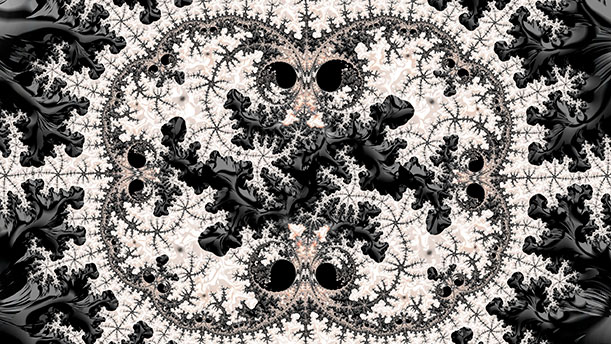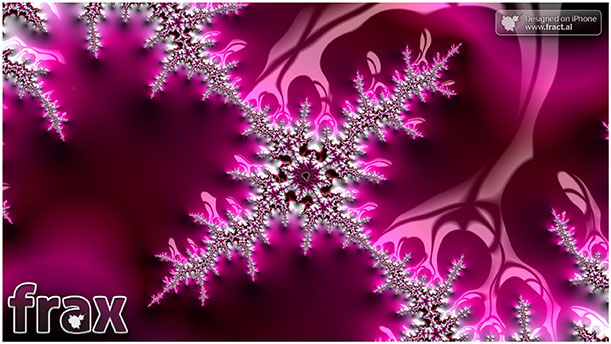A New App Turns Fractals Into Ornate Art
With Frax, users can create mathematically-driven art, adding color, depth and texture to geometric shapes
/https://tf-cmsv2-smithsonianmag-media.s3.amazonaws.com/filer/20131101102020Frax-stylish-spiral-web.jpg)
As a mathematical concept, the fractal can be intimidating. Benoit Mandelbrot, the Polish-born mathematician who coined the term, defined a fractal as “a rough or fragmented geometric shape that can be split into parts, each of which is (at least approximately) a reduced-size copy of the whole.” Fractus, in Latin, means “broken.”
But, the whole idea, I think, becomes a lot more digestible when you look to nature.
The natural world is chock full of fractals. Consider a tree, one of the simplest examples. Whether you look at the entire tree, a branch or a single twig, the shape is generally the same. The same can be said for rivers and their tributaries. This “self-similarity” is a defining trait of a fractal. A fiddlehead—a young fern that is tightly coiled—has little leaflets that form even tinier coils. Similarly, the interior sections of a nautilus shell, all the same crescent shape, get progressively larger from the center of the spiral outwards. Fractal geeks also point to their favorite vegetable: Romanesco broccoli. Each bud of the edible plant is composed of more miniature buds of the same geometric form.
“There’s this moment of awakening where you understand that the natural patterns that you’ve been seeing your entire life are actually based on simple mathematical formulas. And once you’re aware of those patterns—be it the spiral shape of a galaxy or the whirl of a hurricane or the swirls of cream in your morning coffee—you’re able to recognize them anywhere,” says Ben Weiss.
An expert in computer graphics, Weiss has taken it upon himself to make these universal mathematical principles even more accessible. His new iOS app, Frax, which he developed with colleagues Kai Krause and Tom Beddard, puts fractals, as he says, “in the palm of your hand.”
Frax users begin with a basic shape from the app’s fractal library. Then, they manipulate the shape to their own liking, adding depth, shading, color, lighting, gloss and texture. The end result is nothing short of art. The fractals are complex, colorful patterns that conjure any number of things—sea weed, snowflakes, sand dunes and oil spills.
While most will just doodle on their iPhones and iPads, “Some will use it to create more complex works of art, using it as a starting point for fabrics or paintings or digital art installations,” says Weiss. “We’re also hoping that the interaction with these beautiful images will inspire users to want to learn more about the underlying math and geometry, in the same way that looking through a telescope can inspire interest in astronomy and science.”
Weiss’ fascination with fractals took root at an early age. As a 10-year-old, he was writing bits of code and patiently waiting hours for the images to load on the screen of his Apple IIc. For three decades, fractal programs have required users to plug in lots of equations to generate visuals, Weiss explains. He was excited to harness the power of today’s touchscreen devices for this purpose. Frax is built on the famous Mandelbrot and Julia set equations, but, as Weiss told Co.Design, he and his team hid all the mathematical inputs, amounting to almost 100,000 lines of custom code, “under the hood.”
“Not everyone wants to be introduced to something in terms of math,” says Weiss. “There is plenty of complexity hidden away behind the scenes, but the audience is immersed more easily if they don’t see the mechanics behind it all.” (It is a little like slipping fruits and vegetables into desserts.)
Kai Krause, a German software and interface designer involved in the project, has watched kids use Frax. “They clearly have no clue about ‘Mandelbrot’ or the math of it,” he says, and yet they have an appetite for the app, as an entertaining, creative experience. The design team sees Frax as something with broader appeal than other fractal programs on the market, used mainly by math geeks. Krause says they have amplified the play value, without making Frax a game in the traditional sense. “The belief is that you can have serious fun without the need for shooting pigs or people or high scores,” he says.
The experience is immersive, and, as the user zooms in on fractals and makes aesthetic decisions about colors and other effects, he or she picking up skills and developing a more innate understanding of this mathematical art form.
“You’re playing directly with mathematics, but it doesn’t feel dry,” says Weiss. “It feels like an artistic adventure.”
/https://tf-cmsv2-smithsonianmag-media.s3.amazonaws.com/accounts/headshot/megan.png)






/https://tf-cmsv2-smithsonianmag-media.s3.amazonaws.com/accounts/headshot/megan.png)